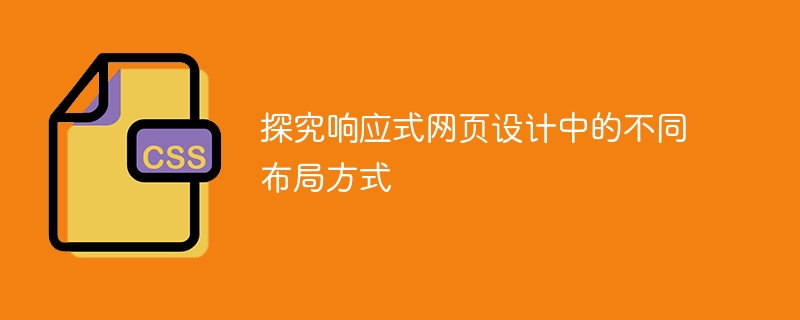

In today’s digital era, responsive web design has become a basic requirement for web design. Responsive design enables web pages to display the best visual effects and user experience on screens of different sizes, providing users with a better browsing experience. In responsive web design, different layout methods play a crucial role. This article will explore different layout styles in responsive web design.
1. Fluid Layout
Fluid layout is a layout method based on relative size, and its proportion is automatically adjusted according to the size of the screen. It uses percentage units to set the width of elements, allowing the web page to adaptively adjust the layout under different screen sizes. Fluid layout has good adaptability and can maintain a relatively stable layout whether on a large screen or a small screen. However, there are also some problems with fluid layout. For example, on extremely wide or narrow screens, it may cause typographical confusion and text that is too small or too large.
2. Adaptive Layout
Adaptive layout is a layout method based on a fixed size that adapts to different screen sizes through media query (Media Query). In adaptive layout, designers will set different layout styles for different screen sizes so that the web page will show the best effect under different screen sizes. Adaptive layout can adapt to different devices more accurately and avoid typesetting problems that may occur with fluid layout. However, adaptive layout also has some shortcomings, that is, independent layout styles and media query codes need to be written for different screen sizes, which increases the workload of design and development.
3. Flexible Layout
Flexible layout is a layout method based on the flexible box model (Flexbox), which can flexibly adjust the size and position of elements. Flexible layout realizes the automatic adjustment of elements by setting the properties of the flexible box model, so that the web page can adapt to the display of different screen sizes. Flexible layout has better flexibility and adaptability, and can better adjust and control the layout of elements. However, elastic layout may not be fully supported on some older browsers, and some compatibility processing or fallback solutions need to be used.
4. Grid Layout
Grid layout is a layout method based on a grid system. The layout is achieved by dividing the web page into grid units of rows and columns. . Grid layout provides more advanced layout control capabilities, allowing you to precisely position and adjust the position and size of elements. Compared with other layout methods, grid layout is more efficient and flexible in typesetting and adjustment. However, grid layout may not be fully supported on some older browsers, requiring some compatibility processing or fallback solutions.
To sum up, the layout method in responsive web design can be selected according to the design needs and target audience. Fluid layout is suitable for keeping the layout relatively stable, adaptive layout is suitable for accurately adapting to different screen sizes, elastic layout is suitable for flexibly adjusting and controlling the layout, and grid layout is suitable for advanced layout needs. In actual design, different layout methods can also be used in combination to obtain better effects and user experience. No matter what layout method is used, attention should be paid to the balance of the design and the needs of the user to achieve the best responsive design effect.
The above is the detailed content of Explore different layout methods in responsive web design. For more information, please follow other related articles on the PHP Chinese website!